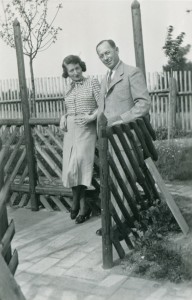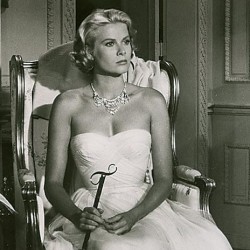Stitching History
After Germany invaded Czechoslovakia in 1939, a young Jewish man wrote to a relative in Milwaukee, carefully crafting a letter that slipped past government censors in Prague. His plea for help to escape to America included an appeal to find work as a dressmaker for his wife, Hedy, along with colorful sketches of her designs.

UW students created designs inspired by the sketches (top) of Hedy Strnad (above left with her husband, Paul), who died in the Holocaust.
“What a catastrophe has overtaken our country,” Paul Strnad wrote, “a catastrophe which has upset our whole life.”
Despite the best efforts of their cousin Alvin, the Strnads never made it to the United States and died in the Holocaust. In 1997, Alvin’s children discovered the letter and sketches and shared them with Jewish Museum Milwaukee. A decade later, researchers there began digging further into the story, ultimately creating an exhibit of eight historically accurate garments brought to life from Strnad’s sketches by the Milwaukee Repertory Theater costume shop. They are a haunting reminder of the immeasurable talent and creativity lost in the Holocaust.
Soyeon Shim, dean of the UW’s School of Human Ecology, visited the exhibit and was determined to bring Strnad’s story to campus to educate and inspire students. Strnad’s garments — made using using period styles and techniques — were displayed in the school’s Ruth Davis Design Gallery last fall, with support from the museum, the Center for Jewish Studies, and private funding. And a companion show — Inspired by Hedy — featured student designers who looked to Strnad’s legacy for a modern twist on styles from the late 1930s and 1940s.
The students dug into the UW’s Helen Louise Allen Textile Collection to research design methods used in Europe during Strnad’s era and used her sketches to imagine what a design house she started would have produced for today’s customers in the trillion-dollar, global fashion-and-textile industry.
“Our students possess the same drive and talent we imagine Hedy had,” Shim says. “They were able to call on a range of textile, cultural, and historical knowledge to conceptualize and execute designs that taught them valuable technical skills and historical background.”
Published in the Spring 2017 issue




Comments
No comments posted yet.